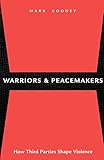Warriors and Peacemakers : How Third Parties Shape Violence / ed. by Mark Cooney.
Material type: TextPublisher: New York, NY : New York University Press, [2020]Copyright date: ©1998Description: 1 online resourceContent type:
TextPublisher: New York, NY : New York University Press, [2020]Copyright date: ©1998Description: 1 online resourceContent type: - 9780814715147
- 9780814723678
- 303.6 22
- online - DeGruyter
| Item type | Current library | Call number | URL | Status | Notes | Barcode | |
|---|---|---|---|---|---|---|---|
 eBook
eBook
|
Biblioteca "Angelicum" Pont. Univ. S.Tommaso d'Aquino Nuvola online | online - DeGruyter (Browse shelf(Opens below)) | Online access | Not for loan (Accesso limitato) | Accesso per gli utenti autorizzati / Access for authorized users | (dgr)9780814723678 |
Browsing Biblioteca "Angelicum" Pont. Univ. S.Tommaso d'Aquino shelves, Shelving location: Nuvola online Close shelf browser (Hides shelf browser)

|

|

|

|

|

|

|
||
| online - DeGruyter African-Americans and the Quest for Civil Rights, 1900-1990 / | online - DeGruyter America in the Gilded Age : Third Edition / | online - DeGruyter Democratic Community : Nomos XXXV / | online - DeGruyter Warriors and Peacemakers : How Third Parties Shape Violence / | online - DeGruyter Scholars of the Law : English Jurisprudence From Blackstone to Hart / | online - DeGruyter States of Rage : On Cultural Emotion and Social Change / | online - DeGruyter The Notorious Elizabeth Tuttle : Marriage, Murder, and Madness in the Family of Jonathan Edwards / |
Frontmatter -- Contents -- Preface -- 1. Introduction -- Violence as Morality -- Third Parties -- Black's Theoretical Paradigm -- Four Foci -- 2. The U-Curve of Violence i -- Status Patterns in Criminal Homicide -- Elite Violence -- Third-Party Social Status -- 3. The U-Curve of Violence 2 -- Violence in Stateless Societies -- Informal Settlement -- 4. Configurations of War and Peace -- Black's Theory of Partisanship -- Feuding without End: Close and Distant Group Ties -- Homicide without Feuding: Close and Distant Individual Ties -- The Dilemma of Violence: Cross-Cutting Ties -- Peaceful Indifference: Distant Individual Ties -- 5. Foundations of Honor -- Classical Honor -- Modern Honor -- Tie Stability -- Statelessness -- 6. Conclusion -- Researching Violence -- Reducing Violence -- Explaining Violence -- Appendix A. Moralistic Homicide -- Appendix B. The Virginia Study -- Appendix C. The Cross-Cultural Study -- Notes -- References -- Author Index -- Subject Index -- About the Author
restricted access online access with authorization star
http://purl.org/coar/access_right/c_16ec
Why do some conflicts escalate into violence while others dissipate harmlessly? Under what circumstances will people kill, and why? While homicide has been viewed largely in the pathological terms of "crime" and "deviance," violence, Mark Cooney contends, is a naturally-occurring form of conflict found throughout history and across cultures under certain social conditions. Cooney has analyzed the social control of homicide within and across over 30 societies and interviewed several dozens of prisoners incarcerated for murder or manslaughter, as well as members of their families. Violence such as homicide can only be understood, he argues, by transcending the traditional focus on the social characteristics of the killer and victims, and by looking at the role played by family members, friends, neighbors, onlookers, police officers, and judges. These third parties can be a source of peace or violence, depending on how they are configured in particular cases. Violence flourishes, Cooney demonstrates, when authority is either very strong or very weak and when third-party ties are strong and boundaries between groups sharply defined. Drawing on recent theory in the lively new sociological speciality of conflict management, Mark Cooney has culled a vast array of evidence from modern and preindustrial societies to provide us with the first general sociological analysis of human violence.
Mode of access: Internet via World Wide Web.
In English.
Description based on online resource; title from PDF title page (publisher's Web site, viewed 06. Mrz 2024)


